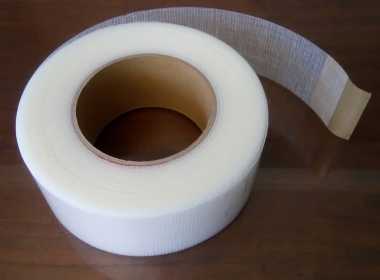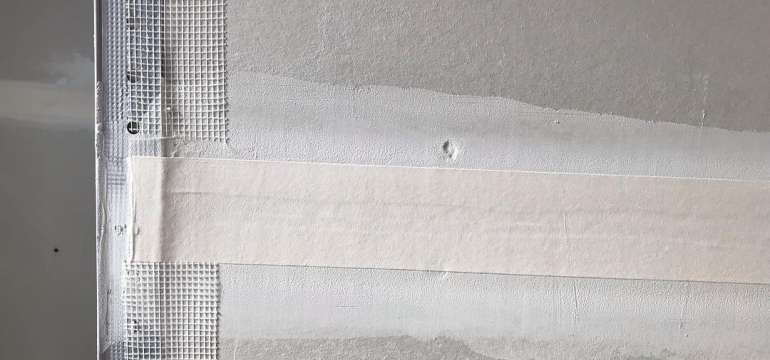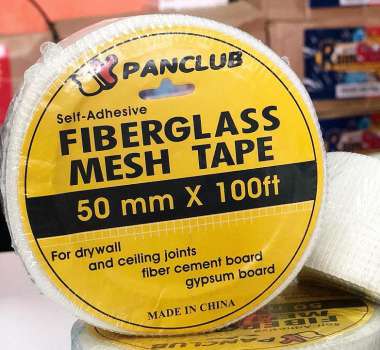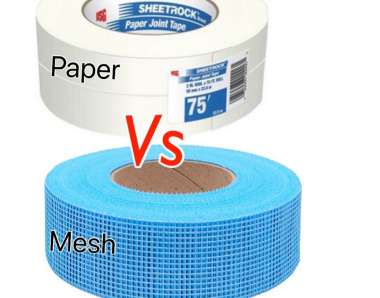When you’re finishing a room in your home, you’ll need to decide how you want to seal off and secure the joints between the sections of drywall. There are a couple of different ways to do this, each with its own advantages and disadvantages.
In this guide, we’ll explore the use of drywall paper tape vs. self-adhesive mesh. If you’re wondering whether to use drywall tape vs. mesh for a room in your home, this guide should help you make an informed decision that works for your timeline and your preferences.
The properties of paper drywall tape
 Paper drywall tape has no adhesive on it. If you’re going to use it, you have to apply a very thin layer of drywall compound first, to serve as the glue behind it.
Paper drywall tape has no adhesive on it. If you’re going to use it, you have to apply a very thin layer of drywall compound first, to serve as the glue behind it.
Paper drywall tape is not recommended for basements and bathrooms, since it might not hold up to even the slightest amount of dampness.
Paper drywall tape is very effective for sealing drywall seams. However, some users point out that it isn’t nearly as strong as the fiberglass mesh tape.

Applying on the corners
On the other hand, paper drywall tape is much easier to work with in the corners of a room. When you’re applying it to a corner area, you can easily crease the paper tape to ensure a flat, tight fit. If you want a crisp, clean, 90-degree corner, paper drywall tape is the way to go.
You can also apply paper tape with any kind of drywall mud or compound. It doesn’t matter whether you prefer premade, quick-setting, or hot mud—paper drywall tape works well with it all.
Another point in favor of paper drywall tape is its lack of elasticity. It doesn’t stretch or flex as much as fiberglass mesh tape might. This is a point in favor of paper drywall tape, especially in reference to butt joints.
Make sure you mix the drywall joint compound according to the instructions on the container or bag. Then, with a clean putty knife, apply joint compound into the crack between the sections of drywall. Fill the crack to the surface, smearing some compound along the edges where the tape will be. Be sure to scrape the area to remove any ridges so you’ll have a thin, uniform layer of the compound. Next, press the paper drywall tape along the seam of the drywall, squeezing out any air bubbles.
The benefits of fiberglass mesh drywall tape
 As you’re considering paper drywall tape vs. mesh, keep in mind that for many users, speed and ease of use is the primary consideration.
As you’re considering paper drywall tape vs. mesh, keep in mind that for many users, speed and ease of use is the primary consideration.
Some builders are used to applying the extra bit of joint compound along drywall seams to serve as the glue for paper drywall tape. It’s a comfortable, familiar process.
For other builders and home renovators, the fiberglass mesh tape is a clear choice. Paper drywall tape definitely takes longer to apply, and as the old saying goes, “time is money.” Many users choose the mesh drywall tape purely on the basis of its speed of use. Since it’s self-adhesive, all you need to do is stick it in place.
Usually, it’s also much easier to lay flat, meaning that you don’t have to spend extra time scraping out any bubbles that might have gotten underneath it.
As previously mentioned, when comparing paper or mesh drywall tape, fiberglass mesh tape is clearly stronger with reference to load-bearing capacity. However, its elasticity means that joints can flex more, which may eventually cause cracks in the drywall. Paper tape, while not as objectively “strong,” is less elastic and holds the joints in place more tightly, with less flex.
To combat the effects of this elasticity, users who apply mesh tape should cover it with drywall compound when they mud the rest of the wall. The compound will help stabilize the tape and minimize flexing.
Repairs or patches to a section of drywall are faster and simpler with self-adhesive mesh tape.
In addition, fiberglass mesh tape is more resistant to mold and decay than the paper drywall tape. However, paper tape still yields the more crisp, attractive look for corners.
Paper drywall tape vs. Mesh: Final results
 Ultimately, if you’re looking for quicker application and an easier workload, fiberglass mesh tape is the way to go. It’s an efficient way to seal the seams of those drywall boards. However, you may want to have a supply of paper drywall tape on hand for the corners of rooms, and for any areas where the drywall joints might benefit from extra stability.
Ultimately, if you’re looking for quicker application and an easier workload, fiberglass mesh tape is the way to go. It’s an efficient way to seal the seams of those drywall boards. However, you may want to have a supply of paper drywall tape on hand for the corners of rooms, and for any areas where the drywall joints might benefit from extra stability.
The taping and mudding phase of a room is incredibly important. It has a huge impact on how airtight and energy-efficient your home will be. Whether you select paper tape or mesh tape, invest in a high-quality product and choose a top-of-the-line kind of drywall mud, too. With top-shelf products and careful application, you’ll have a crisply finished room that you can be proud of, one that will serve your family well for years.
- How to Cut Lexan - September 25, 2020
- Mineral Spirits vs. Mineral Oil - September 25, 2020
- Shellac vs. Polyurethane - September 24, 2020
